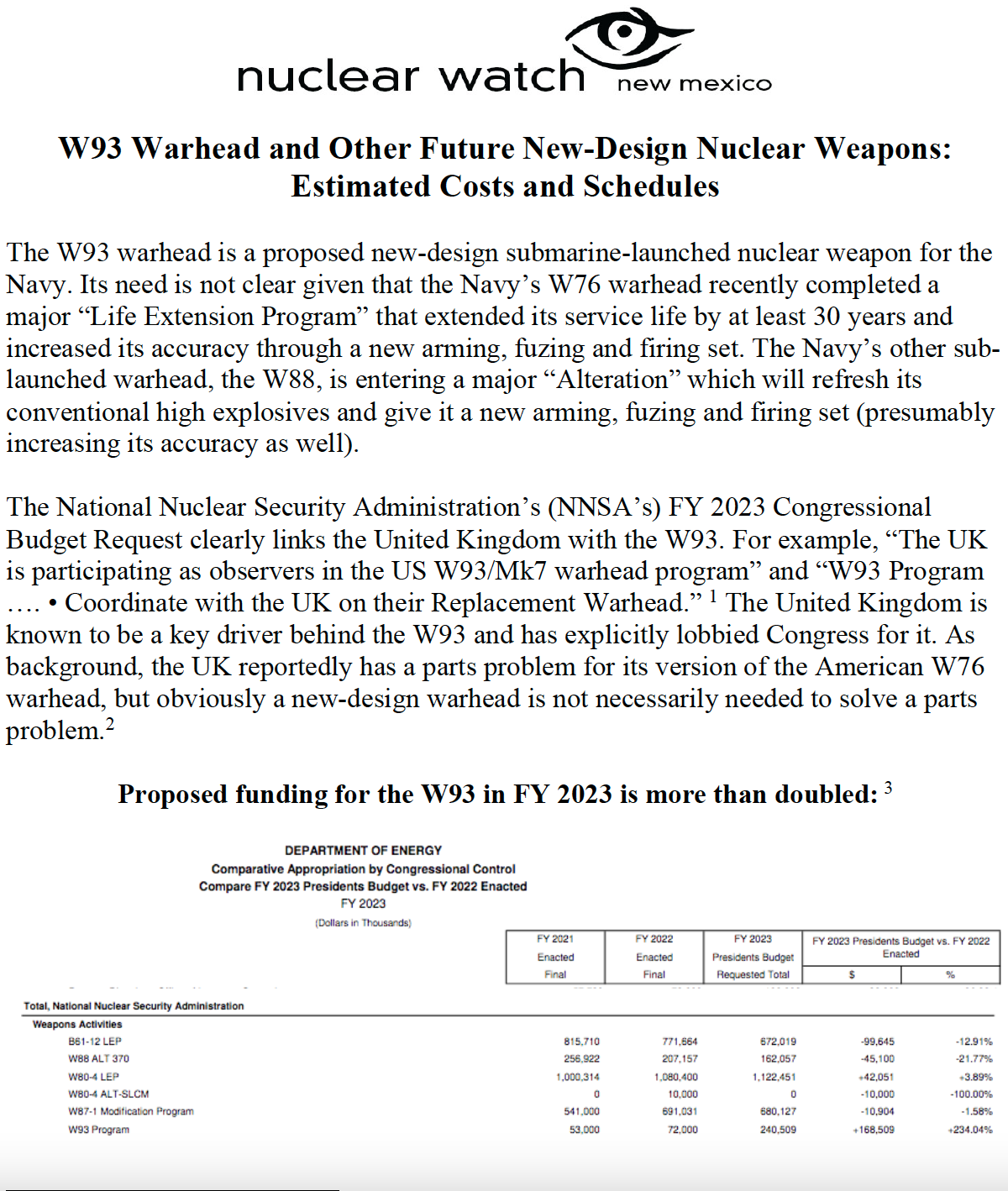Atomic Histories & Nuclear Testing
LANL’s Central Mission: Los Alamos Lab officials have recently claimed that LANL has moved away from primarily nuclear weapons to “national security”, but what truly remains as the Labs central mission? Here’s the answer from one of its own documents:
LANL’s “Central Mission”- Presented at: RPI Nuclear Data 2011 Symposium for Criticality Safety and Reactor Applications (PDF) 4/27/11
VIEW THE RECORDING: Santa Fe Ecumenical Conversations Towards Nuclear Disarmament at Santa Maria de la Paz Catholic Community – Monday, October 27
Archbishop John C. Wester and NukeWatch New Mexico presented a special evening at Santa Maria de la Paz Catholic Community on Monday, October 27, from 6:00 to 8:00 p.m. MT. Following a presentation from NukeWatch executive director Jay Coghlan on U.S. nuclear weapons “modernization,” the Archbishop shared reflections from his pastoral letter, Living in the Light of Christ’s Peace, and speak about the importance of dialogue and hope in working toward nuclear disarmament.
View the recording at https://www.youtube.com/watch?v=9LFmQzMoJds&t=1s
Oppenheimer’s Legacy: South Carolina at the Center of the New Nuclear Arms Race 8/16/23
Learn about the role of the U.S. Department of Energy – and the Savannah River Site in South Carolina particular – in production of plutonium “pits” for new nuclear weapons as a key part of the new nuclear arms race from this August 16, 2023 event: https://www.youtube.com/watch?v=ZK9YOFoT6r0

________________________________
Click the image to view and download this large printable map of DOE sites, commercial reactors, nuclear waste dumps, nuclear transportation routes, surface waters near sites and transport routes, and underlying aquifers. This map was prepared by Deborah Reade for the Alliance for Nuclear Accountability.
Nuclear Watch Interactive Map – U.S. Nuclear Weapons Complex
Waste Lands: America’s Forgotten Nuclear Legacy
The Wall St. Journal has compiled a searchable database of contaminated sites across the US. (view)
Related WSJ report: https://www.wsj.com
The Need for Independent Pit Aging Studies
June 16, 2022 | FACT SHEETS
Summary: The United States is aggressively expanding the production of plutonium “pit” bomb cores to at least 80 pits per year, which the Pentagon has called the number one issue in its $1.7 trillion plan to “modernize” nuclear forces. The average age of plutonium pits is around 40 years. Los Alamos Lab Director Thom Mason has said that “The best way to deal with this dilemma [of uncertainty about aging effects] is to take it off the table. We do that by making new pits, immediately.” Thus, he justifies spending tens of billions of dollars, creating additional occupational and public risks, generating more radioactive wastes with uncertain disposal pathways, fundamentally transforming the Lab into a nuclear weapons production site and fueling the increasingly dangerous new nuclear arms race.
But does independent review of pit aging data support this need to immediately produce new pits? The answer is no given that independent experts concluded in 2006 that pits last at least a century with no determined end date. Further, no future pit production is scheduled to maintain the safety and reliability of the existing nuclear weapons stockpile – it is all for speculative new designs which could raise reliability issues or even prompt the U.S. to resume testing.
Why Funding for the SLCM Nuclear Warhead Should Be Deleted
June 6, 2022 | FACT SHEETS
Introduction: In 1991, in response to the ongoing collapse of the Soviet Union, President George H. Bush ordered the withdrawal of all nuclear-armed sea-launched cruise missiles (SLCMs) from U.S. surface ships and submarines. In 2018 President Trump’s Nuclear Posture Review proposed to redeploy SLCMs on Virginia-class attack submarines, saying they would provide the United States with “a needed non-strategic regional presence” that would address “the increasing need for flexible and low-yield options.”1 Congress subsequently approved $15.2 million in FY 2022 funding for the Navy’s new cruise missile and nuclear warhead.
In March 2022 President Biden transmitted a new classified Nuclear Posture Review to Congress that reportedly canceled the Sea-Launched Cruise Missile. In parallel, his proposed FY 2023 budget for the National Nuclear Security Administration (NNSA) has no funding for the SLCM nuclear warhead. This has prompted some congressional pushback, with one suggested compromise being continuing modest research funding. But as a Congressional Research Service analysis put it: “The Navy indicated that the program was “cost prohibitive and the acquisition schedule would have delivered capability late to need.”
Is Los Alamos Lab Half Empty or Over Full of Radioactive Wastes?
August 22, 2019
The Department of Energy’s (DOE’s) Environmental Management Los Alamos (EMLA) field office has repeatedly claimed that “> [i.e., more than] ½ of legacy cleanup has been completed.”1 This claim doesn’t explain how this is measured. Does it mean ½ of the time, ½ of the cost, ½ of the sites, or ½ of the wastes? However it is measured, New Mexicans need to know that DOE and the Los Alamos National Laboratory (LANL) are NOT talking about real comprehensive cleanup.
When EMLA and its cleanup contractor (N3B) talk about cleanup, they mean specific narrow measures for specific sites, including much paperwork and studies instead of actual cleanup. Contrary to EMLA’s self-proclaimed openness and transparency, the claim of greater that half-completed cleanup is based on decisions made without public input to leave the vast majority of radioactive and toxic wastes permanently buried above our precious groundwater.
While some Lab cleanup started in the late 1980s, tracking of the cleanup budget didn’t start until 1997, which is the date used as the beginning of “prior costs” in recent DOE Congressional Budget Requests. 2 EMLA’s current estimated date for completion of planned cleanup is 2037. That would be 22 years down and 18 to go, if we look at 1997 to 2037, which would be ½ of the time if EMLA completes its planned cleanup by 2037. If decisions are made to remove more wastes, which would be the right thing to do, cleanup could last for decades more while generating 100’s of high-paying jobs. Real, comprehensive cleanup would be well worth the wait!



















